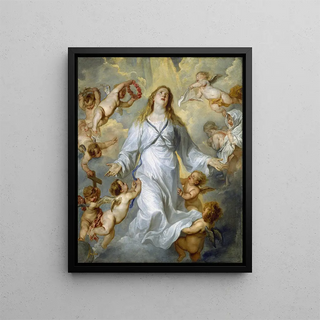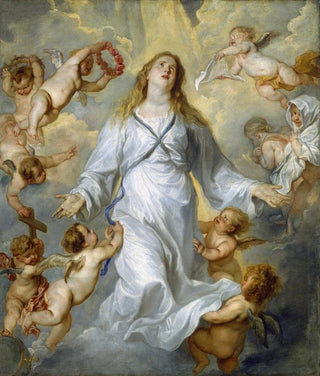Painting La Vierge comme intercesseur - Antoine van Dyck | Art print


View from behind

Frame (optional)
In the fascinating world of baroque art, "The Virgin as Intercessor" by Antoine van Dyck stands as an iconic masterpiece, revealing the spiritual depth and emotion characteristic of this period. This painting, which evokes a divine connection between humanity and the sacred, invites viewers to contemplate the maternal figure of the Virgin Mary, a symbol of compassion and protection. Through this art print, the work comes to life in our contemporary spaces, offering a window into history and spirituality while enriching our environment.
Style and uniqueness of the work
Van Dyck's style is distinguished by his masterful use of light and color, creating an atmosphere that is both solemn and soothing. In "The Virgin as Intercessor," every detail is carefully considered, from the flowing drapery of the Virgin's robe to the delicate expressions of the angels surrounding her. The faces, imbued with gentleness, seem to capture a moment of silent prayer, where the Virgin, at the center of the composition, embodies mediation between heaven and earth. The mastery of chiaroscuro, the technique that plays on contrasts between shadow and light, gives the work depth and an almost three-dimensional quality. The color palette, rich and nuanced, evokes both serenity and majesty, reinforcing the sacred character of the scene.
The artist and his influence
Antoine van Dyck, a pupil of Rubens, is one of the masters of Flemish baroque who managed to mark his era with his exceptional talent. His works, often imbued with religious themes, testify to a unique sensitivity and a deep understanding of human nature. Van Dyck does not merely depict holy figures; he breathes life and emotion into them, making each character a reflection of the human condition. His influence extends well beyond his time, inspiring many artists through the centuries. By integrating portrait elements into his religious compositions, he redefined the genre, paving the way for a more personal and intimate approach to spirituality. "The Virgin as Intercessor"

Matte finish

View from behind

Frame (optional)
In the fascinating world of baroque art, "The Virgin as Intercessor" by Antoine van Dyck stands as an iconic masterpiece, revealing the spiritual depth and emotion characteristic of this period. This painting, which evokes a divine connection between humanity and the sacred, invites viewers to contemplate the maternal figure of the Virgin Mary, a symbol of compassion and protection. Through this art print, the work comes to life in our contemporary spaces, offering a window into history and spirituality while enriching our environment.
Style and uniqueness of the work
Van Dyck's style is distinguished by his masterful use of light and color, creating an atmosphere that is both solemn and soothing. In "The Virgin as Intercessor," every detail is carefully considered, from the flowing drapery of the Virgin's robe to the delicate expressions of the angels surrounding her. The faces, imbued with gentleness, seem to capture a moment of silent prayer, where the Virgin, at the center of the composition, embodies mediation between heaven and earth. The mastery of chiaroscuro, the technique that plays on contrasts between shadow and light, gives the work depth and an almost three-dimensional quality. The color palette, rich and nuanced, evokes both serenity and majesty, reinforcing the sacred character of the scene.
The artist and his influence
Antoine van Dyck, a pupil of Rubens, is one of the masters of Flemish baroque who managed to mark his era with his exceptional talent. His works, often imbued with religious themes, testify to a unique sensitivity and a deep understanding of human nature. Van Dyck does not merely depict holy figures; he breathes life and emotion into them, making each character a reflection of the human condition. His influence extends well beyond his time, inspiring many artists through the centuries. By integrating portrait elements into his religious compositions, he redefined the genre, paving the way for a more personal and intimate approach to spirituality. "The Virgin as Intercessor"
12,34 €






